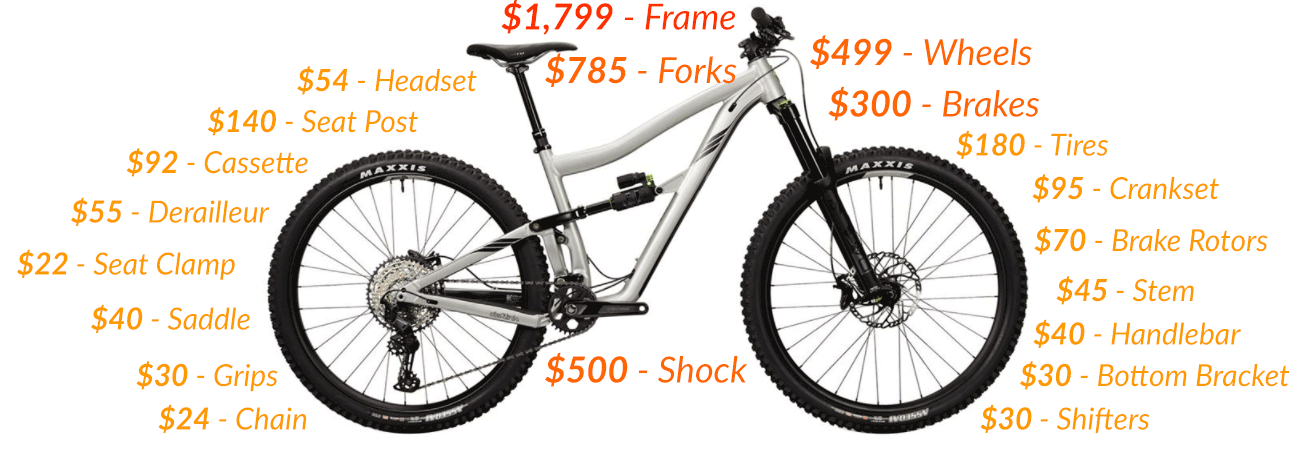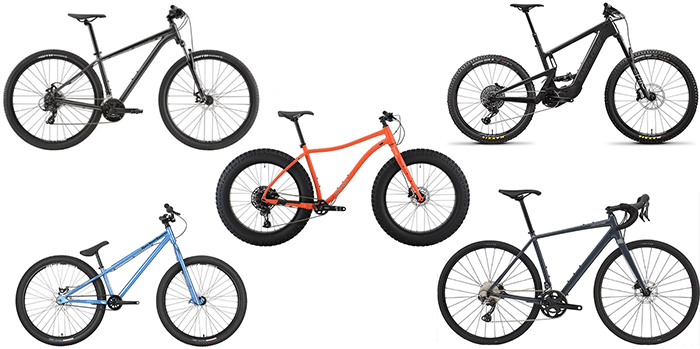Mountain Bike FAQ
Down below you’ll find answers to the most asked questions online. If you think something needs to be added – feel free to add it down to the comments section.
1. How to clean a mountain bike?
Mountain bikes are built to ride off the road which means they’ll get dirty rather quick.
- Get a spray bottle, fill it with water (or soapy water)
- Spray the bike
- Let it sit for a minute
- Use a cloth to sweep off the dirt
- Use an old toothbrush to clean those difficult spots
- Once the frame & wheels are clean, use the cloth to clean the derailleur sprockets and the chain
- Lastly, clean the chain

*Avoid pressure washer as this can ruin the seals and allows the water get to places where it shouldn’t be. Mountain bikes are not waterproof to a degree of submerge.
*Some riders use a thin layer of universal oil on the clean frame as it will give an extra layer on the bike, and the dirt will come off easier next time.
2. Can you ride a mountain bike on the road?
Yes, you can ride mountain bikes on all surfaces, including tar, pavement and concrete, and it’s legal to ride a mountain bike on any road that allows bicycles.
However, mountain bikes are slower and heavier to cycle on pavement, so if you plan to ride mostly on the road, you should rather get a hybrid or road bike.
- Slower
- Good mountain bike tires are quiet expensive, and some use a softer compound which wears out way quicker than it would on the road.
3. How to change a mountain bike tire?
To change a mountain bike tire, you’ll first need to find out if it’s a tubeless tire or not.
Tubeless tires don’t use inner tubes but have a glue sealant around the rim to make them airtight. However, if you don’t have sealant, you can fit any tubeless tire with a spare inner tube.
First, remove the wheel that needs changing and let all the air out of the tire. Then, loosen the bead along the side of the tire so it pops off the rim. If there’s an inner tube, you may need to unscrew the washer, holding the valve in place before removing the tube.
Check the inside of the tire for glass, thorns or debris that may have caused the puncture. If the damage to the tire is not too bad, you can salvage it and just replace the inner tube. Either patch the damaged inner tube with a puncture repair kit or, preferably, replace it with a new tube.
Slip one side of the tire back onto the rim and then slip the new inner tube into the tire, lining up the valve with the hole so you can insert it. Once in place, pump up the inner tube slightly but not all the way – this will fill it out, so it stays in place inside the tire.
Now, you can push the other side of the tire onto the rim with your thumbs, making sure not to pinch the inner tube. Once in place, pump up the inner tube completely and you’re ready to go.
4. When to replace your mountain bike tires?
You should replace your mountain bike tires when the strip along the center of the tire starts to go smooth. Without grip on this section, you won’t be able to brake as quickly and could be in an accident.
Uneven weight distribution means the rear tire on a mountain bike wears out faster than the front, so you’ll find it getting smooth sooner. What many riders don’t realise is that you can just swap the front and rear tires when the rear tire’s tread wears smooth and ride the same distance again before buying replacements.
5. How to raise handlebars on a mountain bike?
If your mountain bike handlebars are too low, there are three ways in which you can raise them.
If you have the right tools, you can remove the top bolt on the headset stem and raise the entire handlebar stem. This takes some time and skill but doesn’t require spending any money.
Second, you can replace the straight handlebars with raised handlebars that bend upwards at the ends for some extra height. And last, you can replace the entire mountain bike stem with an adjustable stem for easily changing height when required.
6. How much does a mountain bike cost?

Mountain prices vary greatly, with some costing as little as $100 and others reaching $10,000 or more. However, the average cost of a decent mountain bike is about $1,000. Bikes below this level are likely to be of an inferior quality.
- Read more: What is the real cost of a bicycle?
7. Why are mountain bikes so expensive?
Modern mountain bikes usually have complex frames built from expensive materials with several components and moving parts.
Add to this the cost of brakes, gears, shocks and suspension systems, all of which need to be built from high-quality materials to withstand tough conditions.
8. How much does a mountain bike weigh?
Mountain bikes weigh anything from 20 lbs (9kg) to 40 lbs (18kg), with the average weight being around 30lbs (14,6kg).
In general, the lighter the mountain bike, the more expensive it will be because lightweight materials cost more to produce.
9. How to bleed mountain bike brakes?
Mountain bikes that use hydraulic disc brakes need to be bled from time to time.
This involves leaking fluid from the braking system and pushing new fluid through it in order to remove bubbles. You do this by removing the brake pads and using a syringe filled with hydraulic mineral oil to bleed the fluid.
10. How to build a mountain bike?
Most mountain bikes come assembled but sometimes, you may need to put it together yourself.
To do this, you’ll need several tools including Allen keys, wrenches, and screwdrivers of varying sizes.
Basic assembly typically involves attaching the wheels, pedals, seat post and handlebars. You can secure the handlebars to the headset with a small Allen key, ensuring the brake levers and gears are level. For the rear wheel, you’ll need to pull the chain around the cassette before slotting the wheel in. Most mountain bikes now use a thru-axle, secured by a large Allen key.
Pedals screw on and can be tightened with a wrench, while the seatpost typically slots in and secures with a quick-release bolt.
11. What size mountain bike do I need?
We have compiled a rough estimation, but recommend ALWAYS checking the correct manufacturers size guide. If you happen to fall in two bike sizes – check out our guidance article about that.
| Rider Height | Centimeters | Rider Inseam | Frame Size | (Frame Size)* | Rider Height |
| 4’10” – 5’2″ | 148cm – 158cm | 25″ – 27″ | 13″ – 14″ | (XS) | 4’10” – 5’2″ |
| 5’2″ – 5’6″ | 158cm – 168cm | 27″ – 29″ | 15″ – 16″ | (S) | 5’2″ – 5’6″ |
| 5’6″ – 5′ 10″ | 168cm – 178cm | 29″ – 31″ | 17″ – 18″ | (M) | 5’6″ – 5′ 10″ |
| 5’10” – 6’1″ | 178cm – 185cm | 31″ – 33″ | 19″ – 20″ | (L) | 5’10” – 6’1″ |
| 6’1″ – 6’4″ | 185cm – 193cm | 33″ – 35″ | 21″ – 22″ | (XL) | 6’1″ – 6’4″ |
| 6’4″ – 6’6″ | 193cm – 198cm | 35″- 37″ | 23″ – 24″ | (XXL) | 6’4″ – 6’6″ |
*This is a rough guide as each MTB Brand has their own size recommendation
12. How to do a wheelie on a mountain bike?
To do a wheelie on a mountain bike, change into a very low gear and slowly start cycling.
When ready, stand up on both pedals, with one foot ready to push down hard. As you push down, jerk the handlebars up with both hands while pedaling forward at the same time.
Be careful not to lean back too far or you’ll fall over backwards. Equally, if you don’t lean back far enough, the bike won’t wheelie. Doing wheelies on a bike can be dangerous, so be sure to always wear a helmet and protective gear.
13. Can you put road tires on a mountain bike?
Technically yes, you can put road tires on a mountain bike.
However, you would be limited to only the widest of road tires if you want them to fit on your MTB rims. WTB, Maxxis and Schwalbe produce some thick road tires mostly designed for touring or commuting bicycles.
14. How to corner on a mountain bike?
To corner effectively on a mountain bike, avoid twisting your body but instead keep everything facing directly forward – your head, shoulders, knees and toes. Then, stand up and as you enter the corner, push down with your legs. This applies pressure to the tires and maximizes your grip.
On berms you can keep both your feet level and your knees bent, pumping through the corner for extra speed. On flat turns, straighten your outside leg slightly and use your shoulders to direct the bike through the turn.
15. How to fix gears on a mountain bike?
Bicycle gearing is complex and requires careful tuning for it to work.
On the rear derailleur, adjust the lower limit screw with an Allen key if gears are sticking. Turn the pedals while tweaking this screw into position until it’s not touching the chain. On the front derailleur, you can tighten the cable until gears transition smoothly. Use the pinch bolt on the cable entering the levers to make further minor adjustments.
16. Can a mountain bike be converted to a road bike?
Again, this is technically possible but wouldn’t produce ideal results.
If you want to use a hardtail mountain bike for road touring or commuting, you could simply put smoother tires on it to improve speed. However, attempting to convert a mountain bike into a road racing bike wouldn’t work well. Mountain bike frames are thick and heavy, with geometry that doesn’t provide an aerodynamic position.




How Much Do Rad Power Bikes Sell For Used? My Bike Has Only A Hundred Miles On It I Haven’t Been Able To Ride My Bike As I Am Shrinking In Height I Have Lost About 2 inches In Height since I Got The Bike, we got the bike in 2018 and paid $1400 For It, How Much are they worth gently used?
Hey Cheryl, you should check similar ads on Craigslist or eBay to get an idea of the resale value.
I think you should be able to get $800-$1,000, but do check the market first.
Good luck!